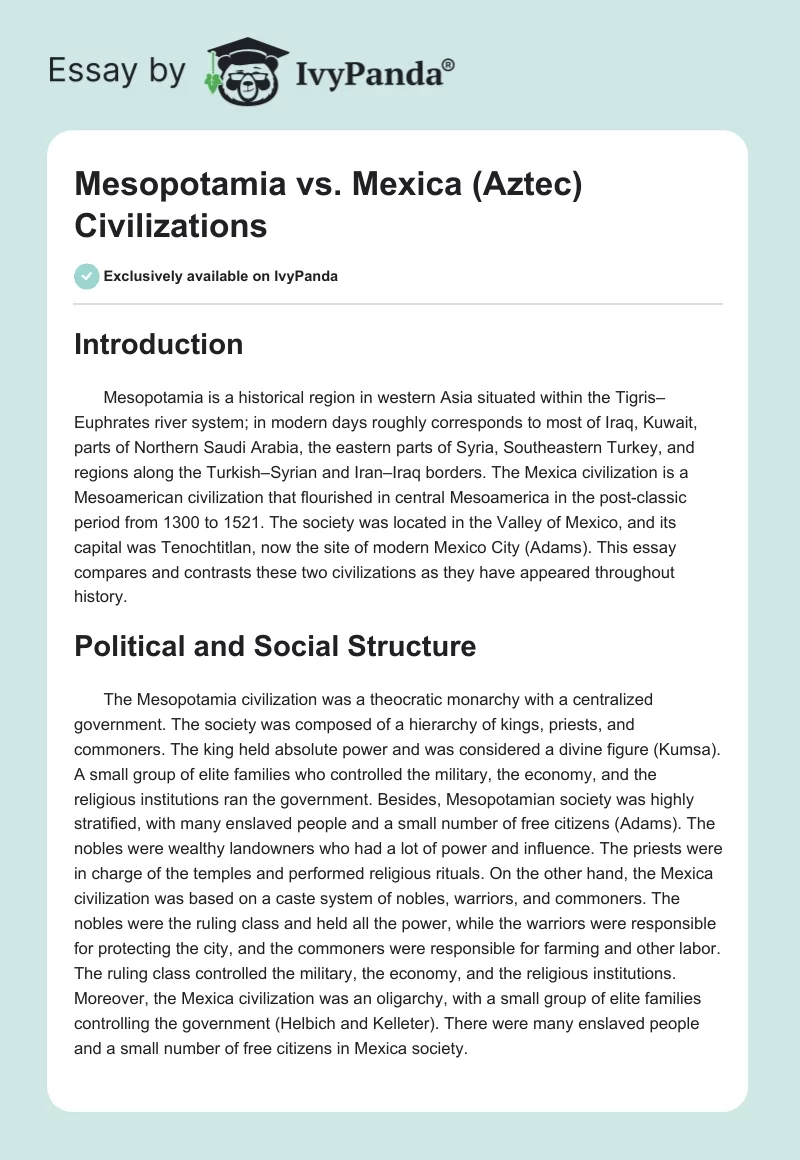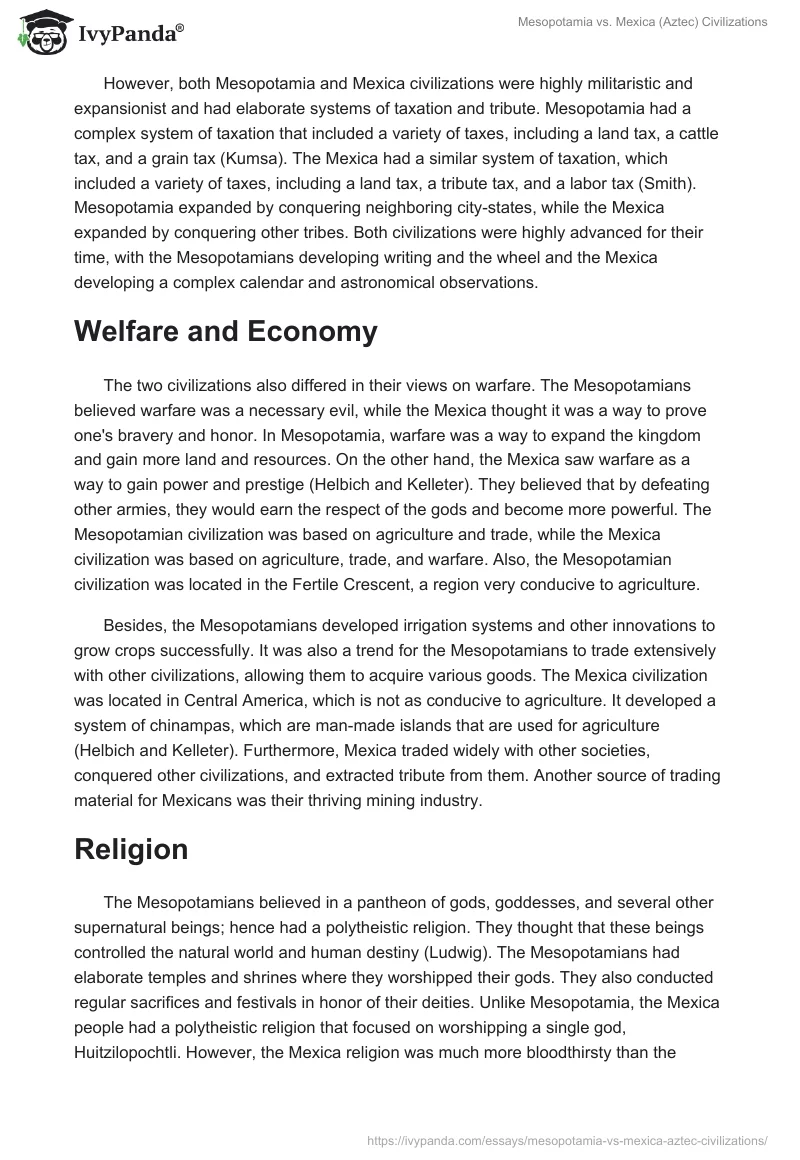Introduction
Mesopotamia is a historical region in western Asia situated within the Tigris–Euphrates river system; in modern days roughly corresponds to most of Iraq, Kuwait, parts of Northern Saudi Arabia, the eastern parts of Syria, Southeastern Turkey, and regions along the Turkish–Syrian and Iran–Iraq borders. The Mexica civilization is a Mesoamerican civilization that flourished in central Mesoamerica in the post-classic period from 1300 to 1521. The society was located in the Valley of Mexico, and its capital was Tenochtitlan, now the site of modern Mexico City (Adams). This essay compares and contrasts these two civilizations as they have appeared throughout history.
Political and Social Structure
The Mesopotamia civilization was a theocratic monarchy with a centralized government. The society was composed of a hierarchy of kings, priests, and commoners. The king held absolute power and was considered a divine figure (Kumsa). A small group of elite families who controlled the military, the economy, and the religious institutions ran the government. Besides, Mesopotamian society was highly stratified, with many enslaved people and a small number of free citizens (Adams). The nobles were wealthy landowners who had a lot of power and influence. The priests were in charge of the temples and performed religious rituals. On the other hand, the Mexica civilization was based on a caste system of nobles, warriors, and commoners. The nobles were the ruling class and held all the power, while the warriors were responsible for protecting the city, and the commoners were responsible for farming and other labor. The ruling class controlled the military, the economy, and the religious institutions. Moreover, the Mexica civilization was an oligarchy, with a small group of elite families controlling the government (Helbich and Kelleter). There were many enslaved people and a small number of free citizens in Mexica society.
However, both Mesopotamia and Mexica civilizations were highly militaristic and expansionist and had elaborate systems of taxation and tribute. Mesopotamia had a complex system of taxation that included a variety of taxes, including a land tax, a cattle tax, and a grain tax (Kumsa). The Mexica had a similar system of taxation, which included a variety of taxes, including a land tax, a tribute tax, and a labor tax (Smith). Mesopotamia expanded by conquering neighboring city-states, while the Mexica expanded by conquering other tribes. Both civilizations were highly advanced for their time, with the Mesopotamians developing writing and the wheel and the Mexica developing a complex calendar and astronomical observations.
Welfare and Economy
The two civilizations also differed in their views on warfare. The Mesopotamians believed warfare was a necessary evil, while the Mexica thought it was a way to prove one’s bravery and honor. In Mesopotamia, warfare was a way to expand the kingdom and gain more land and resources. On the other hand, the Mexica saw warfare as a way to gain power and prestige (Helbich and Kelleter). They believed that by defeating other armies, they would earn the respect of the gods and become more powerful. The Mesopotamian civilization was based on agriculture and trade, while the Mexica civilization was based on agriculture, trade, and warfare. Also, the Mesopotamian civilization was located in the Fertile Crescent, a region very conducive to agriculture.
Besides, the Mesopotamians developed irrigation systems and other innovations to grow crops successfully. It was also a trend for the Mesopotamians to trade extensively with other civilizations, allowing them to acquire various goods. The Mexica civilization was located in Central America, which is not as conducive to agriculture. It developed a system of chinampas, which are man-made islands that are used for agriculture (Helbich and Kelleter). Furthermore, Mexica traded widely with other societies, conquered other civilizations, and extracted tribute from them. Another source of trading material for Mexicans was their thriving mining industry.
Religion
The Mesopotamians believed in a pantheon of gods, goddesses, and several other supernatural beings; hence had a polytheistic religion. They thought that these beings controlled the natural world and human destiny (Ludwig). The Mesopotamians had elaborate temples and shrines where they worshipped their gods. They also conducted regular sacrifices and festivals in honor of their deities. Unlike Mesopotamia, the Mexica people had a polytheistic religion that focused on worshipping a single god, Huitzilopochtli. However, the Mexica religion was much more bloodthirsty than the Mesopotamians (Ludwig). The Mexica believed that human sacrifice was necessary to please the gods and ensure the continued prosperity of their civilization. They conducted elaborate ceremonies, sacrificing thousands of people each year (Smith). The Mexica religion was a major part of their culture and played a significant role in their society.
Conclusion
Mesopotamia and Mexica civilizations were both great civilizations in their own time. Both civilizations upheld cultures that highly contributed to the present-day societies in those places. The most notable feature of Mexica culture is its use of human sacrifice, which was thought to please the gods and bring good luck. The unique feature of the Mesopotamia civilization is its cuneiform writing system, which was used to record laws, historical events, and other important information.
Works Cited
Adams, Robert McC. “The Evolution of Urban Society.” Early Mesopotamia and Pre-Hispanic Mexico. Routledge., 2017.
Helbich, Wolfgang J., and Frank Kelleter. “Prescott, William Hickling: History of the Conquest of Mexico.” Kindlers Literatur Lexikon (KLL), 2020, pp. 1–2.
Kumsa, Alemayehu. “Michael Mann: The Sources of Social Power. Volume I: A History of Power from Beginning to A. D. 1760.” HISTORICKÁ SOCIOLOGIE, vol. 2011, no. 1, 2017, pp. 140–143.
Ludwig, Theodore M. “Religions of Ancient Egypt, Mesopotamia, and Greece.” Sacred Paths of the West, 2015, pp. 87–95.
Smith, Michael E. “The Aztec Empire.” Fiscal Regimes and the Political Economy of Premodern States, 2015, pp. 71–114.


